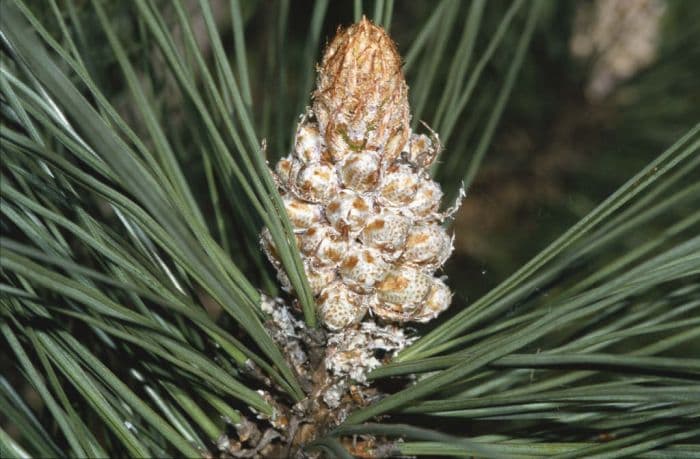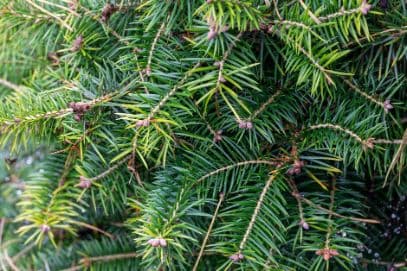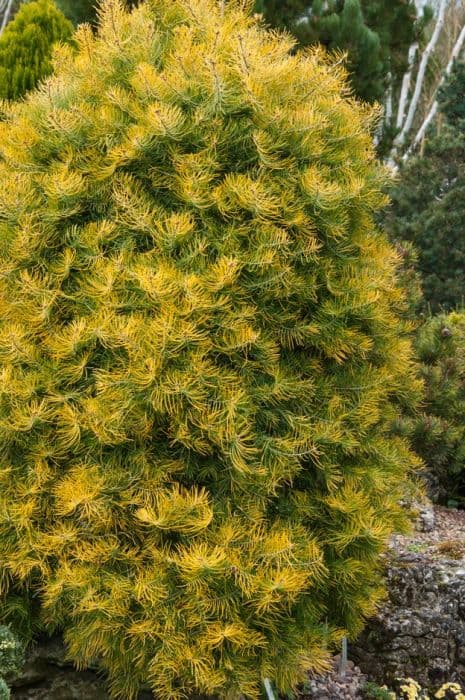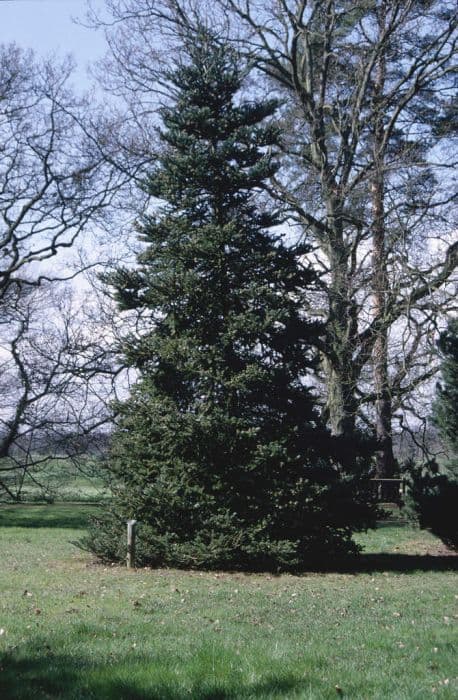Coulter Pine Pinus coulteri

ABOUT
The plant known as Coulter pine is most recognized for its remarkably large and heavy cones, which are among the largest of any pine species. These cones have a distinct appearance, with a grayish-brown color and a thick, hooked scale at the end, creating a very formidable and spiny look. They are so weighty that they are often dubbed "widowmakers" due to the hazard they pose when falling. The needles of the Coulter pine are notably long and come in bundles of three. They are a deep green color that brings a lush appearance to the tree. Branches of this pine tend to be robust and horizontal, contributing to a somewhat open but stout structure that allows visibility through the canopy. The bark of the Coulter pine is a deep brown with grayish hues, forming thick, rugged plates that offer a very textured surface. This rustic bark adds to the tree's overall majestic and rugged appearance, speaking to its resilience and hardy nature. The plant boasts quite an impressive and aesthetic presence with its large cones, sturdy branches, and rich green foliage, making it a notable specimen in the landscapes where it is commonly found.
About this plant
 Names
NamesFamily
Pinaceae.
Synonyms
Coulter Pine, Big-Cone Pine, Nut Pine, Pitch Pine.
Common names
Pinus coulteri.
 Toxicity
ToxicityTo humans
The plant known as Coulter pine is not commonly recognized for its toxicity to humans. However, as with many plants, ingesting large quantities of pine needles can lead to gastrointestinal discomfort or irritation. This tree's nuts are also large and could potentially cause choking if swallowed improperly, but the plant does not contain significant toxins that would lead to poisoning.
To pets
Coulter pine is not specifically known to be toxic to pets. However, as with humans, if pets ingest a large number of pine needles, they could experience gastrointestinal distress such as vomiting or diarrhea. It's always wise to monitor your pets and prevent them from eating non-food plants, as individual sensitivities can vary.
 Characteristics
CharacteristicsLife cycle
Perennials
Foliage type
Evergreen
Color of leaves
Green
Height
40 feet [12 meters]
Spread
30 feet [9 meters]
Plant type
Tree
Hardiness zones
7
Native area
California
Benefits
 General Benefits
General Benefits- Erosion Control: The strong root system of Pinus coulteri, commonly known as Coulter pine, helps stabilize soil and prevent erosion on slopes.
- Habitat for Wildlife: Provides food and shelter for a variety of wildlife, including birds and squirrels that eat its seeds.
- Aesthetic Value: Coulter pine is often used in landscapes for its distinctive long needles and large, ornamental cones, adding natural beauty to parks and gardens.
- Shade and Shelter: The dense foliage offers shade and protection from wind, making it a valuable addition for creating comfortable outdoor spaces.
- Recreational Use: Often planted in recreational areas and parks, offering a natural setting for activities like hiking and picnicking.
- Wood Production: Coulter pine wood is used in construction, for making utility poles, and sometimes in carpentry due to its relative strength.
 Medical Properties
Medical Properties- This plant is not used for medical purposes.
 Air-purifying Qualities
Air-purifying QualitiesThis plant is not specifically known for air purifying qualities.
 Other Uses
Other Uses- The heavy cones of the Coulter pine, often called "widowmakers," can be used as natural barriers or deterrents to prevent soil erosion on slopes or in areas requiring weighted objects to stabilize terrain.
- Wood from Coulter pine is appropriate for rustic furniture making due to its solidity and coarse texture, providing an aesthetic that suits outdoor or country-style homes.
- Coulter pine needles, due to their length and coarseness, are gathered for use in traditional basket weaving and crafting by artisans seeking a natural material.
- The resin of the Coulter pine is sometimes harvested and used as a natural adhesive or sealant for small-scale repairs and crafting projects.
- Because of its majestic and sturdy appearance, the Coulter pine is used ornamentally in large gardens and parks, offering shade and a pine-scented ambiance.
- The pitch from Coulter pine has historic uses such as waterproofing wooden vessels or containers and as a pitch for torches before modern lighting methods were available.
- During festive seasons, large branches or the entire tree can be used as a Christmas tree for those preferring a more natural and rustic holiday decor.
- Coulter pine wood can be used in the creation of musical instruments, especially those requiring softwood, like certain types of drums and soundboards for stringed instruments.
- The tree's sizable cones are sometimes collected for use in decorative arts, floral arrangements, or as natural conversation pieces in interior design.
- Landscape artists might plant the Coulter pine strategically for visual screening to block undesirable views or as a windbreak to protect more fragile plants.
Interesting Facts
 Feng Shui
Feng ShuiThe Coulter pine is not used in Feng Shui practice.
 Zodiac Sign Compitability
Zodiac Sign CompitabilityThe Coulter pine is not used in astrology practice.
 Plant Symbolism
Plant Symbolism- Resilience: The Coulter pine, with its ability to grow on dry, rocky sites and its resistance to fire, represents the ability to withstand hardship and adversity.
- Endurance: Given its long lifespan, the Coulter pine symbolizes endurance and the capacity to live through challenging conditions over a long period.
- Strength: The heavy cones of the Coulter pine, known to be the heaviest cones of all pine species, symbolize physical and emotional strength.
- Wisdom: Pines are often associated with wisdom due to their long lifespan, and the Coulter pine shares this symbolic meaning, representing the wisdom that comes with age and experience.
- Fertility: Conifers like the Coulter pine are often associated with fertility, as their cones represent seeds and the continuation of life.
 Water
WaterThe Coulter pine should be watered deeply, allowing the soil to dry out between watering sessions. Newly planted trees need watering once or twice a week, depending on the soil and climate, with about 10-15 gallons each time for young trees. Mature trees are drought-tolerant and may only require watering every 2-4 weeks during dry periods, especially in hot summer months. It's important not to over-water, as the Coulter pine does not tolerate soggy soil. Adjust watering frequency based on rainfall and check soil moisture to determine when additional water is needed.
 Light
LightThe Coulter pine thrives in full sun exposure and should be planted in a location where it can receive at least 6 hours of direct sunlight each day. It does well in a variety of lighting conditions but grows best in open spaces away from shade-casting buildings or other trees. Ensure that the chosen spot doesn't become shaded as the pine grows and the environment changes.
 Temperature
TemperatureThe Coulter pine is well-suited to survive in a wide range of temperatures, withstanding lows down to about 20 degrees Fahrenheit and highs well above 100 degrees Fahrenheit. Ideally, it flourishes in temperatures between 60 and 75 degrees Fahrenheit. This species is resilient to temperature fluctuations typical of mountain and inland valley climates.
 Pruning
PruningPruning of a Coulter pine is usually limited to removing dead or damaged branches to maintain plant health and prevent hazards. The best time for pruning is late winter or early spring before new growth begins. Pruning is infrequent, often not needed annually; however, any safety issues such as broken limbs should be addressed immediately.
 Cleaning
CleaningNot needed
 Soil
SoilThe Coulter Pine thrives in well-draining soil with pH levels ranging from 5.5 to 6.5. A mixture of sand, loam, and compost is ideal to provide the necessary drainage and nutrients. Regular mulching can help maintain soil moisture and temperature.
 Repotting
RepottingCoulter Pines, being large and slow-growing trees, rarely need repotting once they've been planted in the landscape. In containers, young trees may need repotting every few years to provide space for growth.
 Humidity & Misting
Humidity & MistingCoulter Pines prefer low to moderate humidity levels, typical of their native environments. They are drought-tolerant and do not thrive in high-humidity environments, making them well-suited for arid and semi-arid climates.
 Suitable locations
Suitable locationsIndoor
Not ideal for indoor growth due to size and light needs.
Outdoor
Plant in sunny spot with well-draining soil; water regularly until established.
Hardiness zone
7-10 USDA
 Life cycle
Life cycleCoulter pine (Pinus coulteri) starts its life as a seed, often requiring a trigger such as fire or exposure to sunlight for germination to occur. The seed germinates to produce a seedling, which establishes itself with a taproot and begins to grow needles and a stout stem. As a juvenile, the tree develops its classic pine shape, with whorled branches and a central leader, growing rapidly in height and girth. Upon reaching maturity, which may take several decades, the Coulter pine begins to reproduce, producing large, heavy cones that contain seeds. These cones open to release seeds, which are then dispersed by gravity and animals. The mature Coulter pine enters a period of sustained reproduction, creating new generations, and may live for over a century before eventually dying, decomposing, and returning nutrients to the soil.
 Propogation
PropogationPropogation time
Spring-Early Summer
Propogation: The Coulter pine, commonly known as Pinus coulteri, is best propagated using its seeds. The most popular method involves collecting cones in late summer to autumn when they are ripe but before they have opened. The collected cones should be exposed to heat, which can be done by placing them in a sunny area or a warm room, encouraging the cones to open and release the seeds. Next, the seeds are extracted and preferably stratified for a period of 60-90 days at about 34-40 degrees Fahrenheit (1-4 degrees Celsius) to break dormancy and enhance germination rates. After stratification, the seeds are sown in well-draining soil under conditions that mimic their natural forest understory habitat - partial shade and cooler temperatures. Seedlings usually emerge in the spring and should be cared for until they are strong enough to be transplanted to their permanent location.









